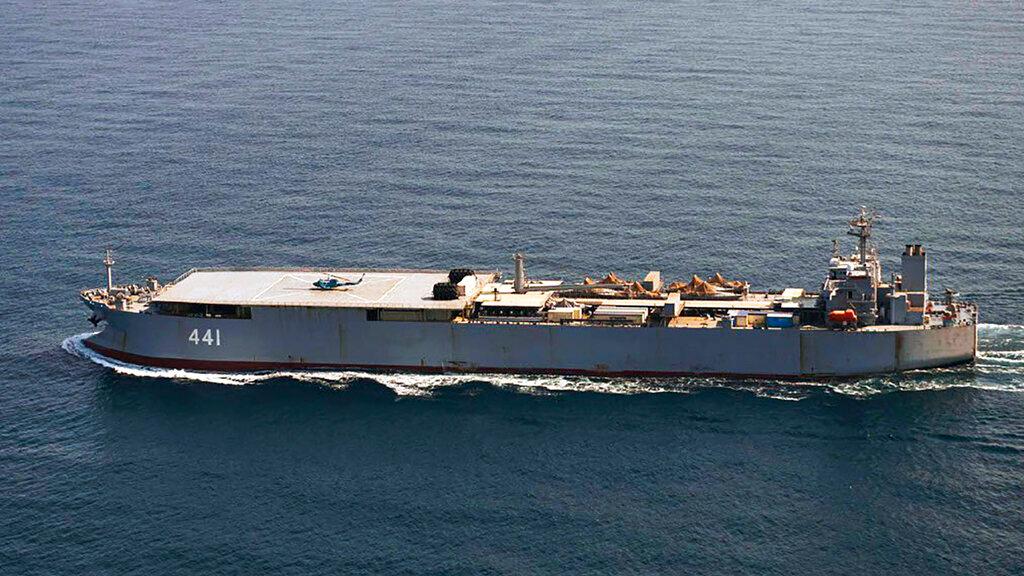Iranian navy ships sail through English Channel en route to Russia for first time
Experts say one of them – a former oil tanker – could be a way for Iran to sidestep US sanctions by transporting petroleum under the flag of a warship.
Just In
A pair of warships from the Iranian navy were tracked sailing through the Baltic Sea on Thursday on their way to St Petersburg, Russia, for a naval parade taking place later this month.
Sailing into the Baltic is a first for the Iranian navy.
Satellite imagery tagged the ships before they entered the English Channel, The Drive reported. The ships were the sea-base vessel Makran and the frigate Sahand, Iran’s most modern warship.
They were first spotted off the coast of Senegal before crossing the Bay of Biscay and sailing into the English Channel, where they were shadowed by Royal Navy warships.
As they crossed into the Baltic Sea, Danish vessels followed, Denmark’s defence ministry said on Thursday.
Oil-tanker-turned-warship IRINS Makran entered the Baltic Sea early Thursday morning under escort by Royal Danish Navy patrol vessels.
Iranian officials had notified authorities in Copenhagen that the ships would be transiting through Danish waters on their way to Russia, the Guardian reported.
“It’s always exciting when we get ships passing that are not everyday events. I cannot remember seeing Iranian warships in Danish waters,” Royal Danish Navy spokesman Per Hansen told newspaper Jyllands-Posten in Danish.
“We will of course sail them out nicely and greet them when they come by. The same applies to the Russian submarines that we have seen in Danish waters this summer.”
The two ships are set to represent Iran in a naval parade in St Petersburg celebrating the 325th anniversary of the Russian Navy, according to a July statement from the Kremlin.
US officials originally thought the ships were making for Venezuela as part of the deepening relationship between Tehran and Caracas but those alarm bells stopped ringing as the pair turned and headed for Europe.
The move into the Baltic could be a sign of wider-ranging future operations, Behnam Ben Taleblu, an Iran expert at the Foundation for the Defense of Democracies, told USNI News on Thursday.
“No doubt, as the Makran and Sahand made their way to the English Channel, Nato countries perked up. It’s not every day that the Iranian Navy makes such a journey, and it could be a harbinger of increased Iranian interest in improving its maritime capabilities and testing range limits,” he said.
Billed as a mobile expeditionary base that can act as a lily pad for small boats, helicopters and unmanned aircraft, Makran could also allow Iran to sidestep US sanctions by transporting petroleum under the flag of a warship.
Some analysts believe Makran could cross the Atlantic to sell the Maduro regime millions of gallons of refined fuel and attack craft. Venezuela, also under US sanctions, has plenty of crude oil but lacks the refining capability to turn it into usable products.
In 2020, four commercial tankers with Iranian gas bound for Venezuela were interdicted by US authorities. Using naval vessels for transport would render any cargo virtually untouchable as transferring oil under the guises of a naval auxiliary would legally prevent interdiction by law enforcement and coast guards, international law experts say.
Iran expert Taleblu told USNI News: “Iranian media has previously touted the storage capability of the Makran, as well as its ability to house drones that could threaten enemy bases that lay outside the range of Iran’s ballistic missiles.”
Whatever the long term aims, analysts agree that the Iranian navy is flexing its maritime muscles.
Subscribe to our newsletter
To be updated with all the latest news and analyses daily.
Most Read
No articles found.
